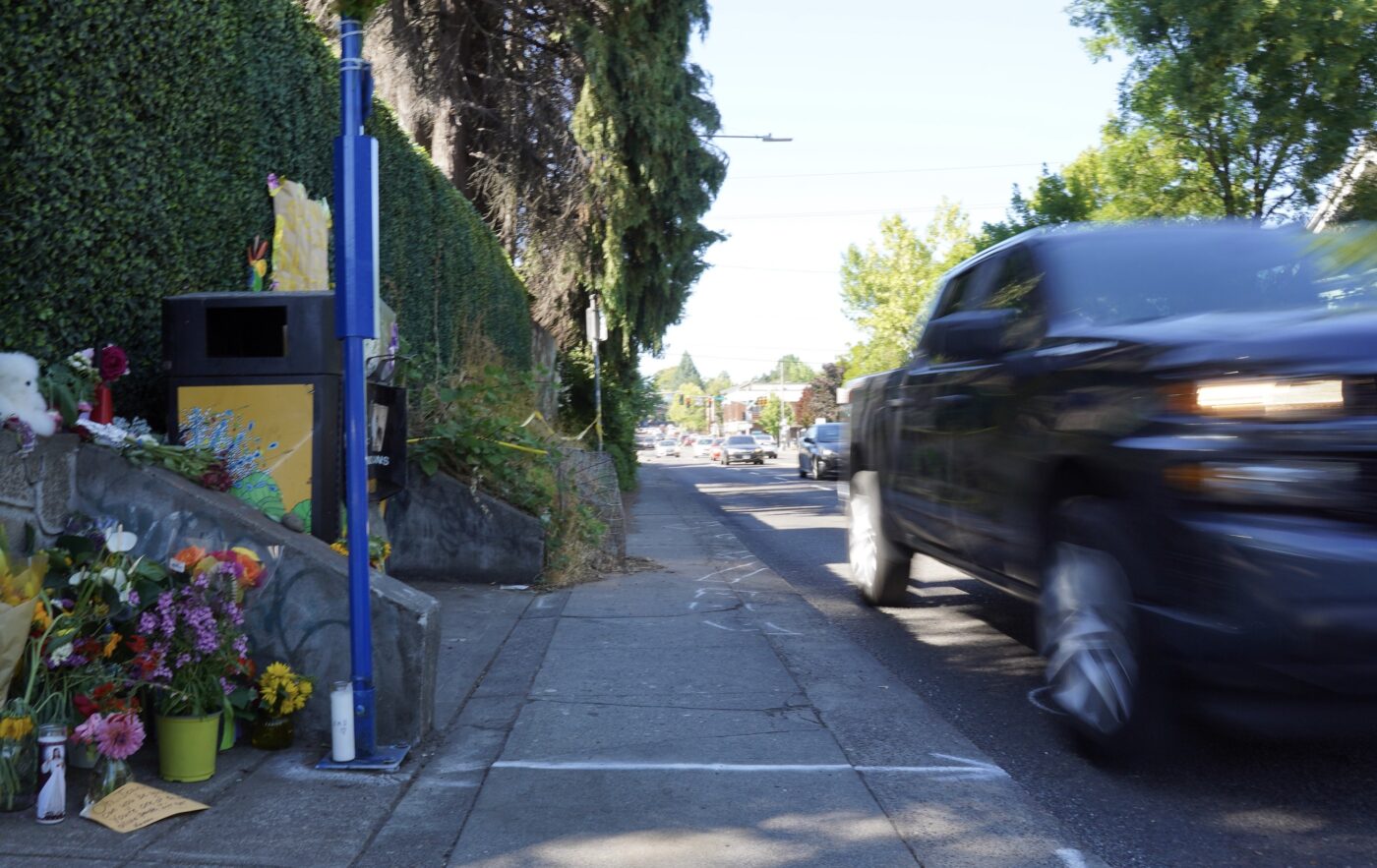
Three months after a woman was killed while waiting for the bus on the corner of Southeast Cesar Chavez Blvd and Taylor, the Portland Bureau of Transportation is set to move forward on a change to the intersection.
On July 15th, 43-year-old Jeanie Diaz had just finished her work day as the children’s librarian at a Multnomah County Library branch across the street from the bus stop when a reckless, speeding, intoxicated driver lost control of their car and rolled onto the sidewalk.
This tragic death on a busy corner of a popular neighborhood greenway street sent shockwaves through the community. It also underscored safety issues on one of southeast Portland’s busiest, most dangerous streets. In 2021, 23-year-old Austin Boyd was hit and killed by a driver while walking on Cesar Chavez at SE Clinton just 0.8 miles south of where Diaz was struck.
PBOT has funded plans to reduce driving lanes on Cesar Chavez south of Taylor from SE Powell Blvd to Holgate, and to build a new signal at Gladstone and Chavez (the intersection where 22-year-old Mark Angeles was killed by a driver while bicycling in 2015). That project isn’t slated for construction in the 2024-2025 fiscal year.
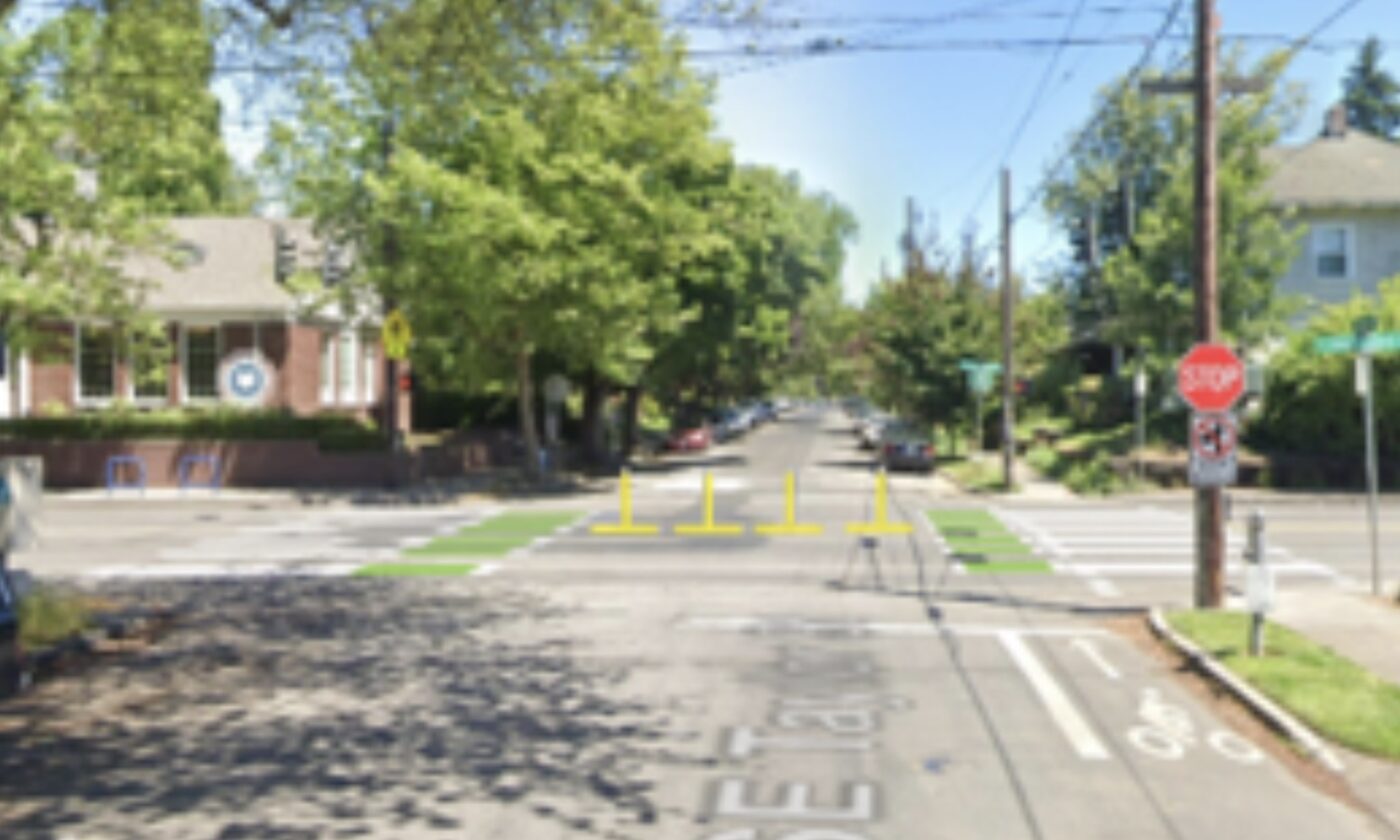
The section of Cesar Chavez where Jeanie Diaz died won’t receive that type of significant change in the near future. Instead, what PBOT just announced to the Sunnyside Neighborhood Association this morning, is a smaller project. They plan to install a diverter at the intersection of Cesar Chavez and Taylor that will prevent left turns to and from Chavez.
In an email to Sunnyside advocates, a PBOT staffer acknowledged this diverter doesn’t directly address what led to the July 15th crash. “However, in addition to the safety benefits I describe above,” wrote the PBOT staffer, “we have found that adding vertical elements, like a diverter, tend to slow driving speeds. The location of this installation may not have stopped the exact actions of the driver in the crash three months ago, but it may slow down a different driver, or discourage dangerous weaving, and that could prevent another tragedy in the future.
According to a PBOT analysis performed as part of their fatal crash review following Diaz’s death, left turns accounted for 25% of all crashes at this location while only 1.7% of all vehicles entering the intersection were turning left.
The diverter should also improve safety for bicycle riders using the SE Taylor greenway and for people walking across the street to reach the library and other destinations.
As for more significant changes to the intersection like a wider sidewalk and/or a buffer between car drivers and sidewalk users? That could only happen if the existing, four-lane cross-section changed — and barring a strong consensus and political pressure from adjacent residents — that’s unlikely to happen any time soon.
“We have talked about… what does it look like… if we go to a three-lane cross-section? Or potentially even a two-lane cross-section?”
– Wendy Cawley, PBOT City Traffic Engineer
At a meeting of the Richmond Neighborhood Association land use and transportation committee on September 26th, PBOT City Traffic Engineer Wendy Cawley said it’s too late to expand the scope of the planned road diet south of Powell Blvd. “That said, we have talked about when we’re doing the analysis of that project south of Powell, what does it look like on the pieces north of Powell up to Stark if we go to a three-lane cross-section? Or potentially even a two-lane cross-section? And so we’re hopeful that there’s some synergy there where we can do some larger analysis.”
If all goes according to plan, the new diverter should be installed by early next month.



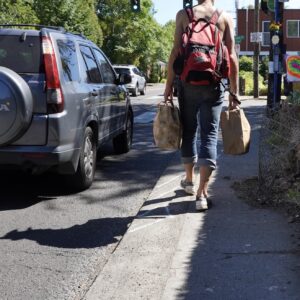
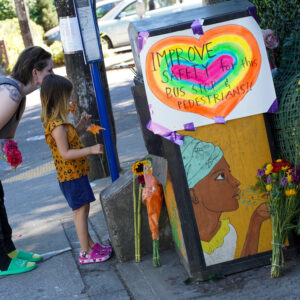
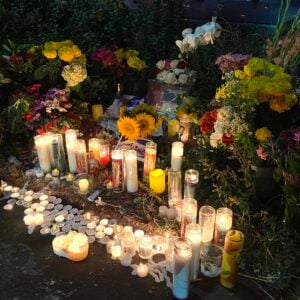
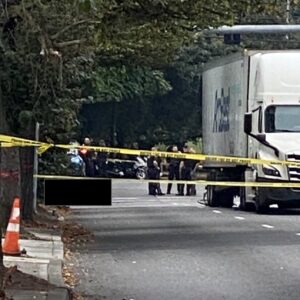
Thanks for reading.
BikePortland has served this community with independent community journalism since 2005. We rely on subscriptions from readers like you to survive. Your financial support is vital in keeping this valuable resource alive and well.
Please subscribe today to strengthen and expand our work.
Just to recap, in order to get PBOT to do something about this deadly intersection:
August 7: A group of two dozen or so bicyclists disrupted Commissioner Mapps’s no-news news conference to demand action, here and throughout Portland.
August 25:I spent over 1.5 hours on August 25 sitting with PBOT Director Millicent Williams at the bus stop where Diaz was killed, during which time Williams expressed how unsafe she felt. I informed her during the conversation that I, another bicyclists, and a pedestrian were nearly struck in this intersection by a car that ran the light just a few weeks after Diaz’s was killed. (But I also make clear, repeatedly, that this is just one deadly intersection in a city full of unsafe streets that need attention.)
September 23: I email Williams to tell her that I and three other bicyclists were just nearly struck in this intersection by yet another car running the red light. I note that her very bad week (SW Broadway scandal, plus the east 70s pause-unpause debacl) would have been even worse if more injuries or deaths had occurred.
September 27: During testimony at City Council about the need to address unsafe streets across the city, I describe the September 23 incident and note that “At least now the continuing danger of vehicular violence along Cesar Chavez will be entered into the record of today’s meeting, so that next time a driver injures or kills someone where Jeanie Diaz, Jocelyn Latka, Mark Angeles, Austin Boyd, and others have already lost their lives to vehicular violence, perhaps it will be easier to sue the city for not acting on a known and documented danger. At yesterday’s working session, Mayor Wheeler indicated he understands how motivating lawyers and lawsuits can be.”
October 8: The Oregonian publishes an Opinion piece calling out the lack of action by city leaders to address vehicular violence.
And at long last, it seems PBOT is going to do something. Unfortunately, it’s something that may actual make the intersection MORE dangerous.
If you use this crosswalk or bikeway regularly, you know that motor vehicles traveling on Taylor frequently turn right onto Chavez while only looking left — that is, the drivers are looking to the left for the break in Chavez traffic so they can turn right, and when they accelerate to make that turn, they are not looking toward the pedestrians or bicyclists they are about to hit. I see this multiple times every week. By creating a barrier that now forces ALL motor vehicles to turn onto Chavez rather than continuing on Taylor, the new design may increase the likelihood of pedestrians and bicyclists getting hit.
PBOT just decided NOT to put up a camera at this intersection that might deter speeding and running of the red light.
PBOT is keeping the extremely narrow sidewalks intact with no barrier or protection, so that everyone walking on Chavez or sitting at the bus stop can feel as terrified as PBOT Director Williams did by how close they are to fast moving traffic.
PBOT is not even changing the timing of the crosswalk signal, to revert back to the shorter wait time that pedestrians and bicyclists previously had.
PBOT is going with the cheapest, quickest, and most dangerous option, just to say they’ve done something. Not something that makes this intersection OR ANY OTHER PART OF PORTLAND safer. Thanks, PBOT leadership.
I guess once the four plastic sticks have been added, those of us who care about safety can stand at the intersection and record how motor vehicles on Chavez continue to run the light, and how motor vehicles turning onto Chavez (without a light) continue to turn without looking right, likely at a higher rate, and then we can testify at City Hall about it, once again noting that when the next death or injury occurs, there will be something on the record about the City’s failure to make this intersection safer … along with all the other unsafe intersections and streets and stroads on which Portlanders are endangered every day.
Road diets treat the symptoms, not the disease. That being, Intoxicated, reckless drivers. The elephant in the room is lack of enforcement. The tweeker running the red light in the stolen RV laughs at your speed camera and plastic barricades.
Enforcement treats the symptoms, not the disease.
Drunk drivers will drive on average 80 times before getting caught. The best thing we can do is reduce the need that people need to drive by re-allocating space for cars to alternatives.
If people know there are consequences for driving drunk or drug impaired, fewer will do so. Unfortunately in the new Portland there are few consequences. Let’s be honest here. Cars are NOT going away anytime soon. To not have enforcement of our laws while we wait for some car free future will condemn many Portlanders to death on our streets.
Oh my god you’re so right. Let’s widen Chavez to 8 lanes in either direction for all those honest, law-abiding, working class SUV drivers just trying to take their 8 children to school. We can put a cop on every corner 24/7 to shoot any drivers who look like they might be intoxicated and/or poor. I’m so glad someone is finally brave enough to say that we need more enforcement!!!!!
Comment of the week even though it’s hard to hear for the anti-enforcement (infrastructure only) commenters on Bike Portland
I imagine a lot of the RVs are abandoned by people and then reported stolen so not to have to deal with liability.
What else do you do with a 30 year old RV that you have to pay to get rid of? These types of people won’t even dispose of a mattress properly.
If the disease is the complete disregard for human life endemic in American Culture, then yes, they do.
But, then, so does enforcement.
Put them all together and maybe we can reduce the grisly toll that motor vehicle take every year in the US.
damn Lois go off. Comment of the week right here
Pretty much why I went from being a 5 year commuter to never riding anymore other than recreation (and it’s always a race to get out of the city). I have a family now and can’t risk it.
Jonathan,
Regarding this statement As for more significant changes to the intersection like a wider sidewalk and/or a buffer between car drivers and sidewalk users? That could only happen if the existing, four-lane cross-section changed — and barring a strong consensus and political pressure from adjacent residents — that’s unlikely to happen any time soon.
On separate occasions I met with two long time activists at the site to review options. A concept was developed that can be found at
https://tinyurl.com/mryhd5hs
This has been sent to the Mayor and Commissioner Mapps. A member of the Mayor’s staff acknowledged receiving it and stated it would be forwarded to appropriate persons.
This concept certainly provides challenges to the standard ways of doing business for PBOT and TriMet. Flexibility, creativity, and courage should be the minimum expectation for these agencies if they intend to walk the talk of Vision Zero.
retaining walls are in the $200-$600 per foot range for cost. The footings go two or more feet out from the wall itself.
Fixed enforcement cameras in Oregon are required to be placed on the top few percent least safe streets. https://www.portland.gov/transportation/vision-zero/safety-cameras
Chavez is a high crash corridor, but none of its intersections are in the top of the high crash locations. Add to that the lack of complete streets east of 82nd, where historical lack of investment has occurred.
Widening sidewalks is a multi-million dollar endeavor per mile, considering all the drainage impacts.
A road diet would be simplest.
So there’s a planned road diet south of Powell on Cesar, and a planned Rose Lane north of Belmont, but nothing substantial can be done in the ~1 mile stretch where multiple deaths have occurred?
Rose Lane is planned from Stark, not Belmont, but yes, that’s right. PBOT won’t even commit to studying a longer Rose Lane connecting these two road diets. I spent a lot of time working with PBOT and NAs on calling for longer and expedited Chavez Rose Lanes and the entire thing was depressing. On top of the safety issue, the cost of the Rose Lane is a few hundred thousand, and the 75 is the 4th busiest bus line in Portland. How are we not able to get this done? The one bright spot is that the Sunnyside NA is an excellent voice.
Have you not heard that PBOT is going broke and has to do a massive budget cut next year? There’s no money for something like this. We need to all be willing to pay higher taxes and fees for transportation if we want this kind of improvement.
I can’t tell if this is sarcastic. Do you know that PBOT’s current road maintenance budget is unable to keep their pavement in good repair, even if every single road was brought up to full repair overnight? This is structural insolvency, not a liquidity/revenue crisis. Rose Lanes are the most cost-effective solution they can implement here (or anywhere), that has positive impacts on several vectors (safety, road maintenance, bus service, modal shift). Saying they can’t pursue it because of budget cuts is exactly the sort of perspective that put PBOT in this position in the first place.
Yes, and due to the current high tax burden (and low services and poor management of existing taxes) in Portland and Multnomah County there is VERY little appetite for additional taxation here.
So what’s holding it up?
PBOT sees (not just classifies) streets as assets, not liabilities. They see the budget problem as a revenue/liquidity issue, not structural insolvency. They are failing, miserably, on their approach to safety, despite actually doing a bunch of stuff. Until they reckon with the utter failure of their current approaches, they aren’t going to operate with the creativity and vision necessary to solve their problems. So what’s holding it up? Lack of leadership and urgency. Look how fast PBOT can make things happen when they think it’s important, like on Broadway.
Just to clarify, the road diet south of Powell is an actual funded project that is definitely happening in a couple years. The Rose Lane concept is north of Stark (not Belmont) and is completely unfunded and might not ever happen. There’s been a lot of misunderstanding about this in the community.
I get that. Under the Rose Lane website, it’s under “exploratory and planning”. But being able to expand the project area of the Rose lane, or even getting the road diet north of Powell as some sort of “unfunded phase 2” of the project would be better than the situation we are in now. Then we would have a tangible safety solution we can rally behind, and knowing that funding might come around. As it stands right now, there are no plans for anything along this stretch of Cesar other than some plastic wands.
Is PBOT planning to put in put the usual plastic posts that can get mowed down on that Cesar Chavez & Taylor diverter? Or solid, sturdy metal bollards that might actually force people driving to look up and slow down a bit?
Definitely plastic based on the rendering in the article. I used to think that was because the city doesn’t want to get sued by a negligent driver’s family when one gets killed running into it but based on the recent City Nerd video about Portland it’s possibly because the engineers know that the next commissioner in charge of the bureau could demand they remove it and plastic is easier to remove than hard infrastructure. Could be both
I’ve been saying for years that every intersection in the city should have a round, concrete planter. Seriously. Because the only thing that reliably gets drivers to slow down and pay attention is something that might damage their vehicle.
Really disappointed to see it’s just plastic. I swear PBOT spends more money on consultants to design these stupid renders than it would cost to just put some actual, life-saving concrete and steel.
no consultant money spent.
They should change the signal timing at Taylor so pedestrians and bicycle riders don’t have to wait so long to get a safe crossing. Recently, PBOT increased the wait time at the pedestrian signal and made it so pedestrians have to push the button at Cesar Chavez and Hawthorne to get a walk signal. Give me a break.
They did change the signal timing … to make the wait longer for pedestrians and bicyclists. I’m not sure when this happened, but it is definitely a longer wait time now than it used to be, part of the privileging of motor vehicles speeding their way along rather than pedestrians and bicyclists going to/from library, K-8 school, bus stops, or other neighborhood destinations.
I know people like to complain about this kind of thing, but it’s actually safer to coordinate the signals so that platoons of cars can travel along the corridor at a slow and steady rate of speed. The green lights are timed for the speed limit, typically. If the signal was super responsive, changing immediately for pedestrians and bicyclists, you would lose all that safety benefit for the corridor and all the people crossing at the unsignalized intersections.
Then why have pedestrian signals? I don’t think having a red light where people stop is faster than having no places where people have to stop. Once stopped, nearby intersections are easier to cross as well. If we are going to have pedestrian signals, they should be responsive to make it worthwhile to use them. I know that when I walk here, I use Taylor so that I can get the walk signal. I definitely don’t use Salmon where it’s completely awkard or Yamhill where it’s also very awkward. The next one beyond Yamhill is the Belmont crossing. The next one beyond Salmon is the Main crossing. So, should we just take out the pedestrian and bicycle signal next to the library and on a neighborhood greenway? Because right now, it had no real value for people to use. There are often gaps in traffic while you wait for the walk signal that I’d be crossing during if I weren’t trying to follow the rules.
This is a residential area in the central city. We don’t want platocns of cars. That’s how people get killed. Whatever makes it more difficult to drive through there is good. If the concrete barrier makes it more likely that you’ll scratch your cat while speeding home from happy hour, that’s good. If you decide to take the freeway instead with your car, that’s good.
It’s also the only major north-south road for 20 blocks in either direction. You make driving down Chavez a backed up, inefficient grind because of a road diet, don’t be surprised when many, many drivers take to side streets and endanger people there too. Sometimes a city just needs some major roads, man. None of these changes would prevent a death caused by someone drunk as a skunk and acting psychotically.
You’re conflating a systemic problem with personal responsibility. While some folks might try to cut through the neighborhoods, there’s not very many streets that run continuously North-South parallel to it. Should be pretty straighforward to install diverters on those streets to discourage rat-running. If they eliminated lanes on Chavez, I suspect that congestion would increase for a few months to a year, then even out to similar ‘delays’ that we currently see. Somehow, all the East-West arterials in that part of the city do just fine with one lane in either direction. Cars and traffic are not some unstoppable force of nature, they are the result of policy and how we choose to allocate space on our streets.
Infrastructure that prioritizes and protects people may not prevent 100% of deaths in whatever edge case fantasy you’re working up in your mind, but neither will – what you’re probably getting at – more cops. Soon as you take the cops off of Chavez, people are right back to speeding and driving recklessly. The infrastructure is there for decades once you build it.
When someone does decide to be ‘drunk as a skunk and acting psychotically’, in the current configuration of thee street, they have nothing to run into but human bodies, homes, and businesses. The cool thing about hard infrastructure is that it doesn’t take 90 minutes to show up and start working like the cops do.
Plenty of well-meaning, put together, sober drivers kill people too, because they are just going too damn fast.
So go that way. You’re in a car, however many blocks is no great hardship. Cesar Chavez has apartments & houses on both sides. No one needs to be speeding down it. The fact that there aren’t enough North/South is not relevant to this particular issue.
New motto for PBOT:
“We perform Vision Zero.”
Finally!
How about PBOT moves the bus sign and pole out to the edge of the sidewalk near the curb and makes it 4 to 6 inches in diameter. That would make is a deterrent to hit by drivers, offer some safety to pedestrians waiting for a bus, and mark or disable cars that stray off the roadway and threaten bystanders.